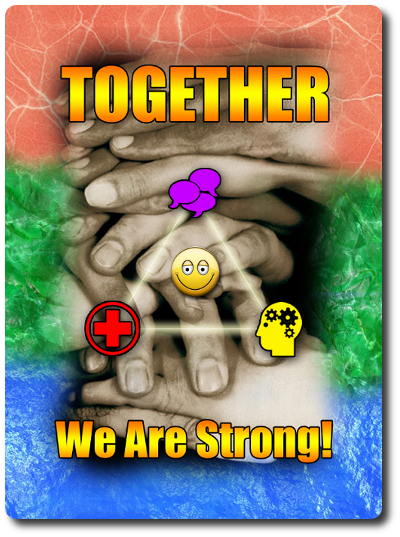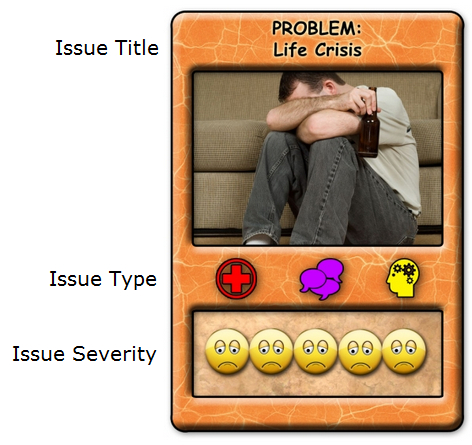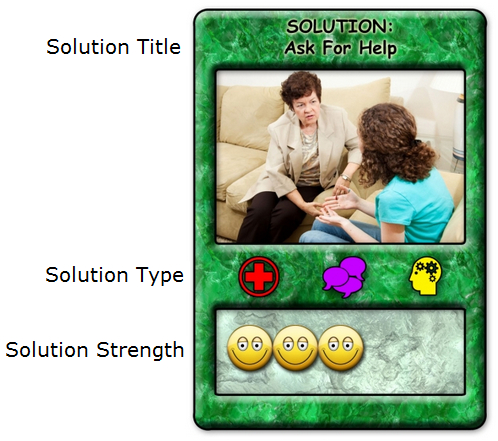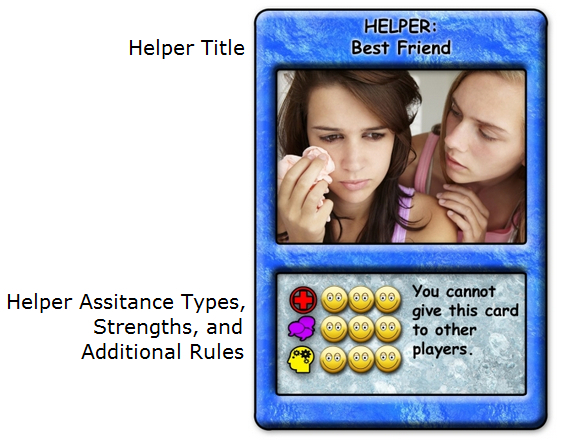
The Basics:
- For ages 5 and up (publisher suggests 12+)
- For 2 to 4 players
- Approximately 15 minutes to complete
Geek Skills:
- Active Listening & Communication
- Counting & Math
- Logical & Critical Decision Making
- Reading
- Pattern/Color Matching
- Cooperative & Team Play
- Hand/Resource Management
Learning Curve:
- Child – Easy
- Adult – Easy
Theme & Narrative:
- There is no problem we cannot solve together
Endorsements:
- Gamer Geek rejected!
- Parent Geek approved!
- Child Geek rejected!
Overview
Gamification is the use of game thinking and game mechanics in a non-game context in order to engage users and solve problems. For this game, solving problems is focused on group cooperative team play to tackle some of life’s most difficult and personal issues. Physical, social, and psychological problems will be presented to the players to address as a group. No one player can do it all alone, however, and only by working together can all the problems be successfully solved.
Together We Are Strong, a self-published card game designed by Andreas Propst, is comprised of 60 playing cards. Not included with the game, but necessary to play, are about 50 beads or chips that can be used to keep track of “Smilies”. There are a few drug references, but nothing that I would personally consider out-of-place for a game that was designed to identify negative influences in our daily lives.
Trials, Tribulations, and Lots of Help
Together We Are Strong has three different types of cards. Each card has a specific role in the game. Each card type is summarized here.
Problem Cards
The Problem card represents a real-life physical, social, or mental issue. For example, anxiety, drug addiction, and unemployment. Some issues are so sever that they have a negative impact to multiple aspects of a person’s life, like a life crisis that has a negative impact on a person’s physical, social and mental state. Accompanying each of the Problem cards are icons that identifies the issue. A cross symbolizes physical issues, speech balloons symbolize social issues, and a head with gears represents mental issues. At the very bottom of the Problem card are a number of “Frownies” that represent the issue’s severity. The more “Frownies” displayed, the more severe (and difficult to solve) the issue is.

Solution Cards
For every problem, there are multiple solutions. The Solution cards represent the many different actions an individual can take to help them resolve the issues that are plaguing them. For example, socializing, working out, and simply talking to someone. Accompanying each of the Solution cards are icons that identifies the Problem issue the Solution can positively counter. A cross symbolizes physical issues, speech balloons symbolize social issues, and a head with gears represents mental issues. At the very bottom of the Solution card are a number of “Smilies” that represent the solution’s strength. The more “Smilies” displayed, the strong the positive impact.

Helper Cards
Helper cards represent people who are capable of assisting an individual deal with and resolve life’s problems. For example, social councilors, doctors, and close friends. Like Solution cards, every Helper has a specific problem or problems they can assist with. Accompanying each of the Helper cards are icons that identifies the Problem issues the Helper can help resolve, but only with the players’ help. A cross symbolizes physical issues, speech balloons symbolize social issues, and a head with gears represents mental issues. Like Solution cards, the “Smilies” represent the strength of the assistance provided. The more “Smilies” displayed, the stronger the positive impact of the Helper. Some Helper cards also have additional text that further expands and alters the standard game rules.

Game Set Up
To set up the game, shuffle the 60 playing cards and deal out to each player 5 cards. The remaining cards in the deck are placed, face-down, in the middle of the playing area. This deck is referred to as the “Draw deck”.
Second, players should now look at their hand and play out in front of them any Problem cards the might have. These represent the starting problems (and not necessarily the problems of the player) that are known by the group that must be collectively solved. If a player is dealt a hand that contains Problem cards that have a combined total of 10 or more total “Frownies”, they can ask for a new hand.
That’s it for game set up. Time to solve some problems!
Strength Through Numbers
The game is played in turns. On a player’s turn they will complete the following steps.
Step 1: Draw Cards
The first step taken by a player during their turn is to draw cards from the Draw deck. The number of cards drawn is dependent on the number of players in the game.
- Draw 3 cards for a 2-player game
- Draw 2 cards for a 3 to 4-player game
If a Problem or Solution card is drawn, they are immediately placed in front of the player, face-up, for all the other players to see. If a Helper card is drawn, the player can either play it in front of them, face-up, or hand it to a player of their choice.
Step 2: Play Cards
The second step taken by a player during their turn allows them to play any number of Solution and Helper cards from their hand and available on the table in front of them. All Problem cards in play, including those visible in front of other players, can be played on. During this step, other players may also assist by providing Solution cards (not Helper cards), but only if they are currently not overburdened with their own issues. A player is considered overburdened if they have 10 or more (12 or more in a 2-player game) “Frownies” in front of them.
Solving Problems is done by matching a Solution card with a Problem card that share the same number of solution/issue types. For example, a Problem that shows a social and mental issue must be matched with a Solution card that only shows a social and mental issue, too. When matched, the Solution card is placed next to the Problem card to identify it is “attached”. A Solution card can only be attached to one Problem during the game, and once attached, cannot be removed. There is no limit to the number of Solution cards that can be attached to a single Problem card.
Helper cards are “boosters” to the Solution cards and cannot solve problems on their own. Each Helper card that is in front of the player can only assist if a Solution card is using a solution type that the Helper provides. For example, the Doctor Helper card provides an additional +2 “Smilies” when matched with a Solution card that provides physical help.
If the Solution and Helper cards ever have a combined total of “Smilies” that is equal to or higher than the “Frownies” of the attached Problem card, the problem is solved! The Problem and any attached Solution cards are placed in the discard pile, but the Helper cards remain in play.
Step 3: Award Smilies
The third step awards “Smilies”, which are the equivalent to victory points in the game.
- If the active player has solved all the Problem cards in front of them, they take 1 “Smilie” bead or chip (whatever is being used) and give it to a player of their choice.
- Every player that helped solved a Problem card that was discarded (by providing Solution cards) collects 1 “Smilie”.
- The active player receives 1 “Smilie” to keep if they solved any Problem cards this round (2 “Smilies” if they solved all the problems without any other player assistance).
The player’s turn is now done and the next player in turn order sequence now goes starting with step 1 noted above.
Collective Victory or Defeat
When a player cannot draw cards during step 1 because there are no more cards left in the Draw deck, the game is over. All the players now count their total number of collected “Smilies”. Together We Are Strong is not a game that is won by a single individual. Victory is shared, but only if all the players have collected a minimal number of “Smilies”.
- In a 2-player game, each player needs to have collected at least 20 “Smilies”
- In a 3-player game, each player needs to have collected at least 15 “Smilies”
- In a 4-player game, each player needs to have collected at least 10 “Smilies”
If all the players have collected the required number of “Smilies” or more, they win!
To learn more about Together We Are Strong and download free print-and-cut “Smilie” tokens for use with the game, visit the game’s web page on the Game Crafter.
Prediction
Together We Are Strong is a game, but it’s a bit heavy for a typical Family Game Night. Some serious and thought-provoking issues are brought up for the players to deal with. Some of which are well beyond the comprehension of younger Child Geeks. For the Parent Geeks, I don’t think this is a game they will really want to put out on their table to play for some “light fun” and you can forget about the Gamer Geeks even considering Together We Are Strong as an approved game for their elitist group.
So who in the heck am I going to give this game to? To quote the game designer, Mr. Andreas Propst, “I designed Together We Are Strong as a tool for therapists, social workers and other professionals working with people with psychosocial problems/handicaps.”
I feel very fortunate that I don’t have individuals with debilitating psychological handicaps in my life at the moment. At most, I have a 3-year-old who refuses to be potty trained. Count your blessings, people. Regardless, I’ll be testing the game with the Child, Parent, and Gamer Geeks, but I’d be doing the game (and the game designer) a serious disservice if I limited it to our typical play groups. Together We Are Strong is clearly a medium (in the form of a game) that is meant to spark conversation, debate, and discussion with a group that is currently focused on learning how an individual can tackle and overcome life’s problems. I’ll have to ask around and see if any of my friends and family have educators or acquaintances who are in the field of medicine or social services that will be willing to take a look at the game. I’m sure I can find someone, but wow, what an interesting situation this is!
Teaching the game to my little geeks wasn’t a problem, as the game is very simple. If you have Child Geek who cannot yet read, feel free to play the game open-handed as Together We Are Strong is a cooperative game. Having no questions from my two oldest little geeks about the game play, I asked them their thoughts on it so far.
“Well…not sure how this is a game, but it looks OK.” ~ Liam (age 8)
“I don’t think I’m going to like playing this, Daddy.” ~ Nyhus (age 5)
Yeah, I don’t think they are going to find that much fun with it, either. I’m going to use this time to discuss the serious issues the Problem cards bring up. Let’s see if Together We Are Strong serves as an excellent opportunity to discuss some of life’s bigger challenges with my family or is ultimately just a problem in itself.
Final Word
Together We Are Strong was not well received by the Child Geeks or the Gamer Geeks. The Child Geeks thought the game was a bit boring (the theme didn’t appeal to them) and the game play was exceedingly too simple for the Gamer Geeks to take seriously. The Parent Geeks gave the game their approval because they think the game has value as an excellent medium in which to initiate conversation with their children about how individuals should address problems and seek help. On this point, Together We Are Strong does very well, but the real story is the social worker I gave the game to.
Turns out a peer of mine at the office happens to have a wife who works as a social worker for the county. While he is not a “big gamer” by any means, he and his wife know their way around a deck of cards. I sent an email to the wife asking if she would be willing to play the game and send to me her thoughts. I can think of no better person to play this game than an individual who works with people and these sort of problems everyday. She agreed. What follows is her notes back to me regarding the game.
Cyrus,
Thanks again for sending me the game. As you requested, I gave the game a try and played it a few times with some of my younger and more “hip” clients. At first, the game wasn’t all that well received, as most of the people I played it with thought I was playing a joke on them or really didn’t understand how the game was meant to be used. In total, I tried the game with five different individuals. Out of those five, four of them warmly welcomed a chance to play the game again.
Cyrus, this is a great little game that I am going to share with my fellow co-workers. It does a great job of allowing the client to discuss with us how they would work to resolve an issue, and it allows us to offer advice on what other programs are available to them. While I am not nearly as experienced as you with games, I can tell you that this one does a great job of initiating conversation and allows for an open dialog with all the participants. Some conversations we had were very frank and I have no doubt they were made all the more easier through this game. I had no idea that games like this existed! Thanks for sharing it with me! Can I keep it?
Well, I must admit that this is a first for Father Geek and I am at a bit of a loss to know how to close this review. For the Parent Geeks, Together We Are Strong was seen as a medium to educate and to share. For the Gamer Geeks and the Child Geeks, they saw the game as not a game at all and didn’t have much interest in it.
The Social Workers loved it.
Clearly, this is a game with a special purpose meant for a special crowd to be played at a special time. The game rules are crisp and the game play is fast, making it easy to teach and to learn for the most non-gamer of gamers. But that’s not the real story here. Together We Are Strong has a very specific intent and a single goal to make players think and find solutions for seemingly very complex problems. It stays on message and reinforces that there is no problem a group cannot solve. If presented and leveraged correctly, I have no doubt it’ll be a wonderful means to a very positive end for those who need some extra help and direction in their lives, as well as a reminder that we are all in this together.
And that’s the kind of message I think we can all benefit from.
This game was given to Father Geek as a review copy. Father Geek was not paid, bribed, wined, dined, or threatened in vain hopes of influencing this review. Such is the statuesque and legendary integrity of Father Geek.
Discover more from Father Geek
Subscribe to get the latest posts sent to your email.





Pingback: Elves vs. Goblins Game Review » Father Geek
Pingback: Making the World a Better Place – Through Games! | Andi's Games Realm
I am a mental health counselor who works with both children and adults with severe and persistent mental illness as well as some who have substance abuse issues. Since the game’s creator is currently not answering emails, do you know where I might obtain a copy of this particular piece of his work? Thank you in advance,
Thomas